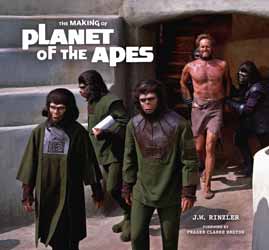|
Click here to return to the main site. Book Review
In celebration of the fiftieth anniversary of Planet of the Apes, New York Times bestselling author J. W. Rinzler tells the exciting, and largely unknown, story of this legendary Hollywood production. Meticulously researched and designed to capture the look and atmosphere of the film, The Making of Planet of the Apes explores behind-the-scenes tales, newly discovered details, and never-before-seen photographs and concept art – including rare journal pages and sketches from star Charlton Heston’s private collection – as well as unit photography, posters and more unique ephemera. Comprehensive in scope, this is the definitive look at the original blockbuster film, a must-have for fans, film buffs and collectors alike… The 1968 science-fiction film Planet of the Apes was an enormous success and spawned a franchise that has so far included four sequels, two television series, one remake and three prequel / reboot movies. However, author J. W. Rinzler has unearthed more than enough material on the first film alone to fill this weighty tome – all 304 hardback-bound, 29 x 27.4cm pages of it. The Making of Planet of the Apes (I do keep wanting to move that first “the”, to form Making of the Planet of the Apes, to reflect the wording of several of the sequels!) covers everything from Pierre Boulle’s original crafting of the source novel, La planète de singes, through the battle to secure studio interest to make the movie, the development of the script and the all-important make-up effects, the casting and the filming, all the way to the extravagant publicity materials that were used to promote the finished product. Or, as The Simpsons once put it, everything “from chimpan-A to chimpan-Zee”! In order to tell this story, the author has sifted through interviews with many of the people involved, as well as contemporary production correspondence and press coverage. Sometimes these differing viewpoints do not entirely agree with each other, but rather than simply overlook certain problematic perspectives (as he was accused of doing in The Making of Star Wars), Rinzler puts all of the statements together in context before making an assessment as to which individual(s) might be misremembering the situation or just plain fibbing. Inevitably, each reader will approach this work with their own points of interest, aspects of the production process that particularly appeal to them – and what I find especially fascinating is the scripting. The author describes the narrative’s evolution from an initial treatment that fairly closely resembled the original book (which featured a technologically advanced ape society on an alien planet) to what finally made it on to the big screen. Brief summaries and excerpts are included from Boulle’s novel and from rejected versions of the screenplay. To be honest, I wouldn’t have minded a bit more detail about these, as each summary runs to just two to four pages. However, if you really want to explore this aspect further, several discarded drafts can be found at Hunter’s Planet of the Apes Archive. Visually, The Making of Planet of the Apes is very well designed. Headings make use of the title font familiar from movie posters and official merchandise, and the layouts incorporate motifs from the Apes universe. The book is richly illustrated throughout, including photographs from private collections and rare reproductions of original concept art and design drawings – only a few of which have been blown up a little larger than their resolution will comfortably allow. You maniacs! You blew it up! Ah, damn you! God damn you all to hell! (Sorry, I got carried away there.) If you want to find out who the producers’ original choices were to play the astronaut Taylor (or rather Thomas, as he was called in the original script) and the primitive Nova, whose idea it was to include the Statue of Liberty in the film, how this was achieved on screen, or which articles featured in the promotional newspaper The Ape (the scans of which are large and clear enough to be read in full), then this hefty volume is well worth getting your stinking paws on. The follow-up Planet of the Apes films and television series are only fleetingly mentioned here, so I would welcome similar simian works about them. Perhaps there isn’t sufficient interest or material to justify one book per movie, but maybe the sequels could be dealt with in pairs – and there are plenty of unused scripts left over from the live-action television show. The only trouble is, you might need an ape to lift them all! 9 Richard McGinlay Buy this item online
|
|---|


